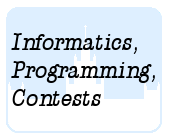Подразделы
Другие разделы
| Тренировка 1 |
| Тренировка 3 |
| Тренировка 4 |
| Тренировка 5 |
Дата и время
06/01/2026 18:40:32
 Тренировка 2
Тренировка 2
A. Phone List B. Cuckoo Hashing C.Optimal Parking D. Copying DNA E. Circle of Debt F. Full Tank? G. Nested Dolls H. Shopaholic I. Moogle
 I. Moogle
I. Moogle
 Олимпиадные задачи на английском языке
Олимпиадные задачи на английском языке
| 04/02/2008 | Зима 2008 дорешивание (2I) |
| 05/02/2008 | Тренировка (задачи Nordic CPC 2007) (I) |
Ограничения: время – 2s/4s, память – 64MiB Ввод: input.txt или стандартный ввод Вывод: output.txt или стандартный вывод 
Послать решение Blockly Посылки Темы Где Обсудить (0)

You got the original idea of making map software, called Moogle
Maps, for the new cool Maple mPhone. It will even be capable
of indicating the location of a house address like "Main Street 13".
However, since the mPhone has limited storage capacity, you need to
reduce the data amount. You don't want to store the exact location of
every single house number. Instead only a subset of the house numbers
will be stored exactly, and the others will be linearly interpolated.
So you want to select house numbers that will minimise the average
interpolation error, given how many house locations you have capacity
to store. We view the street as a straight line, and you will always
store the first and the last house location.
Given that you've stored the locations `x_i` and `x_j` for the houses
with numbers `i` and `j` respectively, but no other house in between,
the interpolated value for a house with number `k` with `i\ <\ k\ <\ j` is
`x_i\ +\ (x_j\ -\ x_i)\ *\ (k-i)/(j-i)`.
Input specifications
The first line of input gives a single integer, `1\ ≤\ t\ ≤\ 50`, the number of test cases.
For each test case, there are two lines. The first contains `2\ ≤\ h\ ≤\ 200` and `2\ ≤\ c\ ≤\ h`,
where `h` is the number of houses in the street and `c` is the number of house locations that
can be stored. The second contains `h` integers in increasing order giving the location of
the `h` houses. Each location is in the interval [0, 1000000].
Output specifications
For each test case, output the average interpolation error over all the `h` houses for the
optimal selection of `c` house locations to store. The output should be given with four
decimal places, but we will accept inaccuracies of up to `±0.001`.
Sample input
2 4 3 0 9 20 40 10 4 0 10 19 30 40 90 140 190 202 210
Output for sample input
0.2500 0.3000

 Начало
Начало